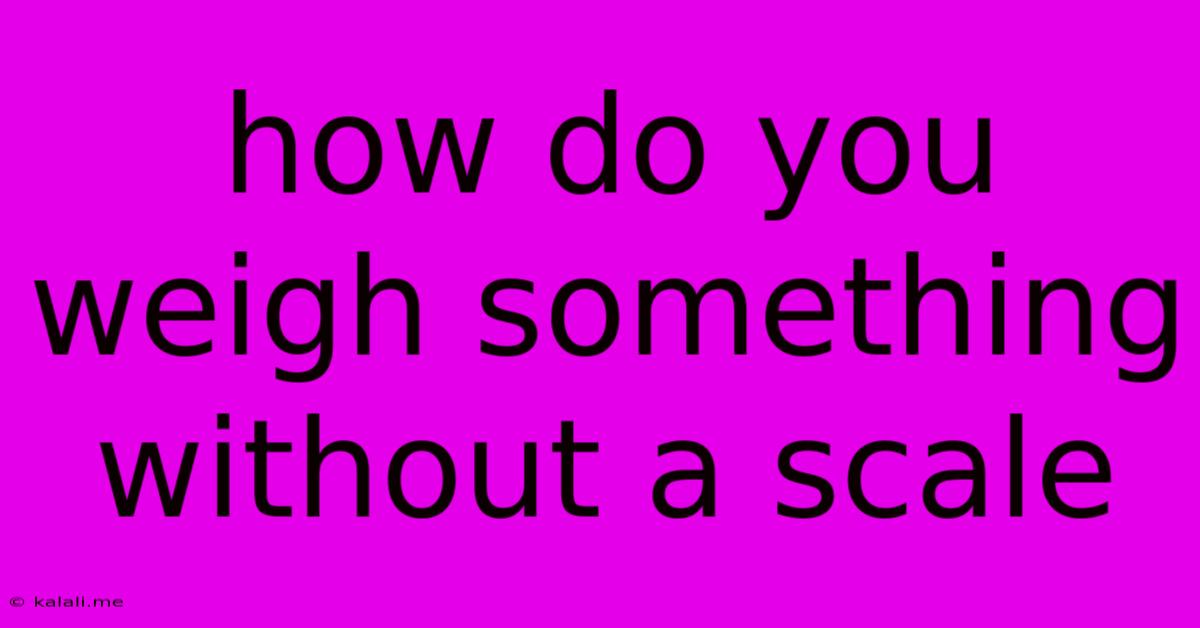How Do You Weigh Something Without A Scale
Kalali
May 21, 2025 · 4 min read

Table of Contents
How to Weigh Something Without a Scale: Ingenious Methods for Everyday Weighing
Knowing how to weigh something without a scale can be incredibly useful in various situations – from camping trips where scales are unavailable, to needing a quick estimate in a pinch. While precision might be lacking compared to a digital scale, these methods offer surprisingly accurate estimations depending on the object and your needs. This article explores several creative techniques to determine the weight of an object without using a traditional weighing scale.
Understanding the Limitations: It's important to acknowledge that these methods won't provide the same level of accuracy as a proper scale. These are estimations, best suited for situations where a precise measurement isn't critical. The accuracy of each method depends heavily on the object's density and your ability to make consistent comparisons.
Method 1: Using Water Displacement (Archimedes' Principle)
This classic method leverages Archimedes' principle – an object submerged in water displaces a volume of water equal to its own volume. While this doesn't directly give weight, it provides a volume measurement which, coupled with the object's density, allows for a weight calculation.
- What you'll need: A container (graduated cylinder is ideal), water, a measuring tool (ruler or markings on the container), and knowledge (or estimation) of the object's density.
- How it works: Fill the container with a known volume of water. Note the initial water level. Carefully submerge the object completely. Note the new water level. The difference between the two levels represents the volume of the object. Then, you'll need to find the object's density (easily found online for common materials). Finally, use the formula: Weight = Volume x Density. Remember that density is usually expressed in grams per cubic centimeter (g/cm³) or pounds per cubic foot (lb/ft³). You might need to perform unit conversions.
Method 2: Balance Method using a Ruler and a Fulcrum
This method is ideal for comparing the weights of two objects. It relies on the principle of levers and balance.
- What you'll need: A sturdy ruler or stick, a fulcrum (a stable point of support, like a pencil), and an object of known weight.
- How it works: Place the ruler on the fulcrum. Place the object of known weight on one side of the fulcrum. Then, place the object you want to weigh on the other side. Adjust the position of the objects until the ruler balances. The weight of the unknown object can then be calculated using the lever principle: Weight₁ x Distance₁ = Weight₂ x Distance₂. The distances are measured from the fulcrum to each object. Solving for the unknown weight will give you an estimate.
Method 3: Using a Spring and a Ruler (Crude Spring Scale)
This method simulates a spring scale. Accuracy depends on the spring's elasticity and the ruler's precision.
- What you'll need: A strong spring (like a coil spring), a ruler or measuring stick, and something to securely attach the spring and ruler (tape or clamps).
- How it works: Attach one end of the spring securely. Attach the ruler to measure the spring's extension. Hang the spring vertically. Then, attach the object to the spring. The extension of the spring is directly proportional to the weight, provided the spring is within its elastic limit. You'll need to calibrate this method by hanging objects of known weight to establish a relationship between extension and weight.
Method 4: Estimation Based on Similar Objects (Comparative Weighing)
This is the least precise method, relying on your knowledge and judgment. It’s helpful when you have a reasonable idea of the weight of similar objects.
- How it works: If you're trying to determine the weight of a bag of apples, for example, and you know that a similar-sized bag usually weighs around 2 pounds, that's your starting point. Consider if your bag feels heavier or lighter and adjust accordingly. This relies heavily on experience and intuition.
Remember, these methods provide estimates rather than precise measurements. For accurate weight determination, a proper scale is always recommended. However, in situations where a scale isn't available, these ingenious methods can be surprisingly helpful.
Latest Posts
Latest Posts
-
Find A File In Linux Recursively
May 21, 2025
-
I Made A Fireable Mistake At Work
May 21, 2025
-
How To Turn Off Hot Water
May 21, 2025
-
Can You Have Sex On Ramadan
May 21, 2025
-
The Hobbit Or Lord Of The Rings First
May 21, 2025
Related Post
Thank you for visiting our website which covers about How Do You Weigh Something Without A Scale . We hope the information provided has been useful to you. Feel free to contact us if you have any questions or need further assistance. See you next time and don't miss to bookmark.